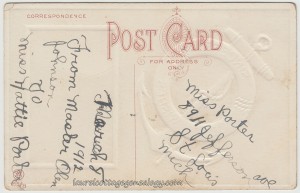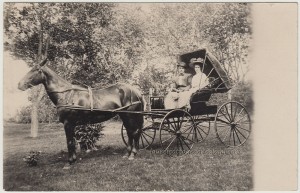

Here at Laurel Cottage Genealogy, we already had a number of cards bearing the “Double A” publisher logo with the beautiful and distinctive spiral postcard back header, but none of ours also included the “Copyright 1909 By S. M. Salke” until we happened across the one posted above.
Below: “Copyright 1909 By S. M. Salke”

An example of the Double A logo with the postcard series number below.

Below, the Pre-Nash, (see link for E. Nash below) spiral header (cleaned up a little in Photoshop). The design was likely fashioned around “S” for Salke: You can see how the line continues into an S shape if you follow it under the “For Address Only” printing.

So, previously, in our research to find out who belonged to the mysterious Double A initials, we were a little stuck. It was already thought by some that the Double A stood for the publishing company, “Anglo-American” however there was no proof of that. And, historically speaking, the thing with postcard publishers (as we’ve come to learn) is that there were scads of them. They came and went. Some few lasted decades or even hit the century mark and are still in existence today, usually having morphed into some other name, eventually bought out by such-and-such corporation, or whatever, and some lasted only a very short time. So, without proof one would not want to assume: “A A” is too open to possibilities. To add intrigue into the mix, the spiral design above would also appear under the publisher known as E. Nash. See Laurel Cottage’s post, E. Nash, Postcard Publisher. But now with the Salke name to research, we were able to find the entry in WWI Draft Registration cards, which shows the American Art Production Company, thus the Double A likely stood for American Art. (We wouldn’t want to say for sure, as it’s always possible they were just letters, and the AAPC name was then created out of the logo.) But here is Sanford Morris Salke’s WWI Draft Registration Card below:


Per the above, Sanford Morris Salke stated he was self-employed and the owner of the American Art Production Company; address given on the WWI Draft Registration Card is 141 Wooster St., New York. He gave his present occupation under the title General Military Goods Supply. He was born June 15, 1884 in the United States. His wife’s name was Maud Tishman Salke; at the time they lived at the corner of Carpenter and Hiawatha Ave. Hollis, Queens, NY. He was 34 years old when he filled out his draft reg card, which was September 12th, 1918.
About 19 months prior to the date on this WWI draft reg, we find that the American Art Production Co. had become incorporated (around February 1916) according to a short mention in the weekly publication Geyer’s Stationer: The company manufactured felt pennants, novelties, pillow tops, draperies and souvenirs, and its chief officers were E. W. McInnes, J. E. and S. M. Salke, address 409 W. 129th St., New York, NY. Who was J.E.? J. E. Salke was Jesse Salke, Sanford’s younger brother, born about 1893. And the 1917 New York City directory lists Jesse Salke as Secretary, and Sanford as Treasurer/President.

Jumping up to the 1920 Federal Census for the Bronx, NY (for more family info) we find Sanford and Maude and two children, Gilbert, age seven, and Marjorie, age two. Also living in the household is domestic servant, Agnes Meehan. Sanford is listed as the employer, for a knit goods manufacturer. Sanford and the kids are native to New York, while Maude is listed to be from Georgia.
Records galore…
In continuing on, if Sanford is your ancestor, you’ve hit the jackpot for source info, as there are an overwhelming amount of records: city directories (1911 – 1959) Federal and State Census, marriage and birth index, and even the Civil Court, where he is named as the plaintiff in a case in 1933 against a Mr. George Bohman. The 1905 NY State Census shows Sanford with his parents, Louis (born Germany) and Henrietta, and siblings and others. In 1905, the father, Louis’ occupation is salesman, in 1910 Louis is just listed as “own income.” But in 1911 and 1913 (city directories) we see father, Louis, and son, Sanford in the “cards” business, with their business address at 413 Broadway, New York City. So, who started the business is unknown, or perhaps it was a joint effort.
Enter E. Nash in 1913….

Above, the same spiral S design but now with “Copyright E. Nash.” This appears on a card postmarked September 3, 1913. So prior to this date, but probably in 1913, Sanford Salke and his father, Louis, have gotten out of the postcard business, and gone into novelties, continuing in the souvenir genre with the aforementioned pillows, pennant flags (and curtains – souvenir draperies or just drapes?). The 1915 State Census for Louis shows his occupation under “novelties” and at some point in there Jesse had joined in. Louis is retired by 1920 or earlier (per the census). In 1920 Sanford was probably still with AAPC (woolen knits re souvenirs?) but by 1922, per the city directory, he’s gone into the insurance business. And then later on he earns a living in real estate. As for the American Art Production Company, the last address found for them, per a Google eBooks (snippet view) is in 1927, when the company was located at 90 Manhattan St., New York City.
Sources: Registration State: New York; Registration County: Queens; Roll: 1818488; Draft Board: 185. Ancestry.com. U.S., World War I Draft Registration Cards, 1917-1918.
Year: 1920; Census Place: Queens Assembly District 4, Queens, New York; Roll: T625_1233; Page: 9A; Enumeration District: 279; Image: 685. (Ancestry.com).
Geyer’s Stationer, Vol. 61, No. 1528, February 17, 1916. p. 27. (Google eBook). Web accessed April 3, 2016.
Year: 1910; Census Place: Manhattan Ward 12, New York, New York; Roll: T624_1027; Page: 20A; Enumeration District: 0719; FHL microfilm: 1375040. (Ancestry.com).
R. L. Polk & Co.’s Trow’s New York City Directory, 1917. p. 1706. (Ancestry.com. U.S. City Directories, 1822-1995.)
New York State Archives; Albany, New York; State Population Census Schedules, 1905; Election District: A.D. 29 E.D. 01; City: Manhattan; County: New York; Page: 17
Louis Salke: Year: 1910; Census Place: Manhattan Ward 12, New York, New York; Roll: T624_1020; Page: 5B; Enumeration District: 0477; FHL microfilm: 1375033.
Trow’s New York City Directory, 1911. Vol. CXXIV. p. 1285. (Ancestry.com. U.S. City Directories, 1822-1995.)
R. L. Polk & Co.’s Trow’s New York City Directory, 1913. p. 1361. (Ancestry.com. U.S. City Directories, 1822-1995.)
Film Year Book – Page 576. Google eBook snippet view. Accessed April 3, 2016.





















